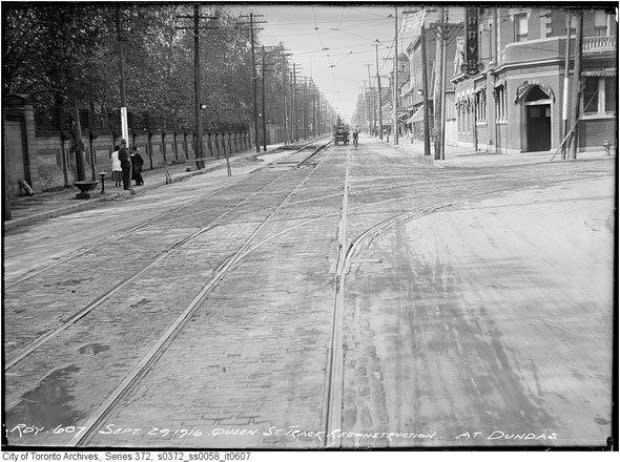CAMH getting rid of piece of Toronto history by tearing down portion of wall, critics say
The Centre for Addiction and Mental Health is erasing a piece of the city's history by taking down a section of the wall surrounding the the property, community members in the West Queen West neighbourhood say.
The stone wall around the heritage building on Queen West dates back to the 1800s and has a surprising history.
Patients were tasked with building it as part of their treatment, explained Parul Pandya with Community Impact Non-Profit Consulting.
Pandya's firm, alongside Myseum of Toronto, recently hosted an event about the wall at the CAMH facility.
"I would like it to be preserved as it is," Pandya told CBC Toronto.
"I think that it speaks to the legacy of mental health in the city," she said. "These folks who were probably the most vulnerable folks were taken advantage of in terms of providing free labour."
The wall is located at the CAMH site near Queen Street West and Shaw Street at what was formerly known as the Provincial Lunatic Asylum.
But a recent redevelopment has meant a section of the wall had to come down.

History of the wall
In 1851, the Provincial Lunatic Asylum, was partially enclosed on three sides by a three-metre-tall wall made of brick, stone foundation and capped piers.
Ten years later, a wall along the south side was added. Subsequently, the original east and west walls were moved in 1889 to their present locations in conjunction with the site's boundary re-allocation.
Over the years, parts of the wall were demolished, rebuilt, replaced, opened up for new entrances, and restored.

In 1997, the City of Toronto designated the remaining wall and a former carpenter's shop and storage shed, built around 1888, as heritage properties.
CAMH Queen Street redevelopment project
In an effort to modernize mental health care, CAMH Queen Street is undergoing a redevelopment.
Two new hospital buildings are being built, creating a unique neighborhood for patients.
As a result, the centre says a portion of the wall has to go.
"There is a very small portion of the wall that is being removed as part of our ongoing redevelopment project," said CAMH's spokesperson, Janet Mawhinney.
"That process has happened ... It was extensive consultation and city approvals, and oversight, as it should be with anything important and historic."
'A really important part of history'
She said a small section of the east wall will be removed, in order to accommodate a new roadway that will eventually connect Stokes Street with Shaw Street, while increasing pedestrian access.
The remainder of the north section of the east wall is scheduled for preservation to ensure the historic integrity, long-term stability and appearance of the structure.
Bricks previously removed from the wall will be used to replace crumbling and structurally unstable bricks.
"The wall is a really important part of the history of Toronto. Much of it predates Confederation. It was built in different time periods over a couple of decades," said Mawhinney.
"The vision with redevelopment is really integration with the local community — preserve the wall and preserve the history but also to create a greater integration with the rest of the grounds."

Historic significance remains, CAMH says
CAMH has placed plaques along the wall to inform the public of its history and Mawhinney said there is a self guided audio tour that community members can listen to as they walk the site.
"You can just use your phone. You dial up and you can get the recordings and it tells the history of the wall and it was designed and code designed by a person with lived experience," she said.
She also says the wall signifies how far society has come when it comes to thinking about mental health.
But Pandya said some of the attendees at the workshop who were accessing services at CAMH aren't so sure.
"They still very much felt isolated from the rest of the community. They still very much feel isolated. So I think there's still a lot of work to be done in that physical representation on that wall — how far we've come but how far we need to go."

